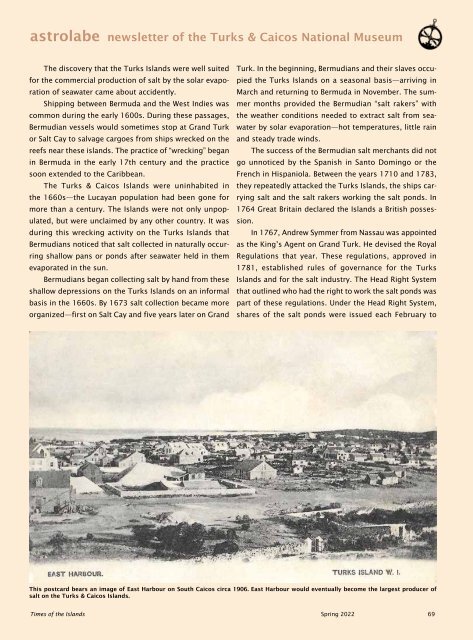Times of the Islands Spring 2022
Presents the "soul of the Turks & Caicos Islands" with in-depth features about local people, culture, history, environment, real estate, businesses, resorts, restaurants and activities.
Presents the "soul of the Turks & Caicos Islands" with in-depth features about local people, culture, history, environment, real estate, businesses, resorts, restaurants and activities.
Create successful ePaper yourself
Turn your PDF publications into a flip-book with our unique Google optimized e-Paper software.
astrolabe newsletter <strong>of</strong> <strong>the</strong> Turks & Caicos National Museum<br />
The discovery that <strong>the</strong> Turks <strong>Islands</strong> were well suited<br />
for <strong>the</strong> commercial production <strong>of</strong> salt by <strong>the</strong> solar evaporation<br />
<strong>of</strong> seawater came about accidently.<br />
Shipping between Bermuda and <strong>the</strong> West Indies was<br />
common during <strong>the</strong> early 1600s. During <strong>the</strong>se passages,<br />
Bermudian vessels would sometimes stop at Grand Turk<br />
or Salt Cay to salvage cargoes from ships wrecked on <strong>the</strong><br />
reefs near <strong>the</strong>se islands. The practice <strong>of</strong> “wrecking” began<br />
in Bermuda in <strong>the</strong> early 17th century and <strong>the</strong> practice<br />
soon extended to <strong>the</strong> Caribbean.<br />
The Turks & Caicos <strong>Islands</strong> were uninhabited in<br />
<strong>the</strong> 1660s—<strong>the</strong> Lucayan population had been gone for<br />
more than a century. The <strong>Islands</strong> were not only unpopulated,<br />
but were unclaimed by any o<strong>the</strong>r country. It was<br />
during this wrecking activity on <strong>the</strong> Turks <strong>Islands</strong> that<br />
Bermudians noticed that salt collected in naturally occurring<br />
shallow pans or ponds after seawater held in <strong>the</strong>m<br />
evaporated in <strong>the</strong> sun.<br />
Bermudians began collecting salt by hand from <strong>the</strong>se<br />
shallow depressions on <strong>the</strong> Turks <strong>Islands</strong> on an informal<br />
basis in <strong>the</strong> 1660s. By 1673 salt collection became more<br />
organized—first on Salt Cay and five years later on Grand<br />
Turk. In <strong>the</strong> beginning, Bermudians and <strong>the</strong>ir slaves occupied<br />
<strong>the</strong> Turks <strong>Islands</strong> on a seasonal basis—arriving in<br />
March and returning to Bermuda in November. The summer<br />
months provided <strong>the</strong> Bermudian “salt rakers” with<br />
<strong>the</strong> wea<strong>the</strong>r conditions needed to extract salt from seawater<br />
by solar evaporation—hot temperatures, little rain<br />
and steady trade winds.<br />
The success <strong>of</strong> <strong>the</strong> Bermudian salt merchants did not<br />
go unnoticed by <strong>the</strong> Spanish in Santo Domingo or <strong>the</strong><br />
French in Hispaniola. Between <strong>the</strong> years 1710 and 1783,<br />
<strong>the</strong>y repeatedly attacked <strong>the</strong> Turks <strong>Islands</strong>, <strong>the</strong> ships carrying<br />
salt and <strong>the</strong> salt rakers working <strong>the</strong> salt ponds. In<br />
1764 Great Britain declared <strong>the</strong> <strong>Islands</strong> a British possession.<br />
In 1767, Andrew Symmer from Nassau was appointed<br />
as <strong>the</strong> King’s Agent on Grand Turk. He devised <strong>the</strong> Royal<br />
Regulations that year. These regulations, approved in<br />
1781, established rules <strong>of</strong> governance for <strong>the</strong> Turks<br />
<strong>Islands</strong> and for <strong>the</strong> salt industry. The Head Right System<br />
that outlined who had <strong>the</strong> right to work <strong>the</strong> salt ponds was<br />
part <strong>of</strong> <strong>the</strong>se regulations. Under <strong>the</strong> Head Right System,<br />
shares <strong>of</strong> <strong>the</strong> salt ponds were issued each February to<br />
This postcard bears an image <strong>of</strong> East Harbour on South Caicos circa 1906. East Harbour would eventually become <strong>the</strong> largest producer <strong>of</strong><br />
salt on <strong>the</strong> Turks & Caicos <strong>Islands</strong>.<br />
<strong>Times</strong> <strong>of</strong> <strong>the</strong> <strong>Islands</strong> <strong>Spring</strong> <strong>2022</strong> 69
















